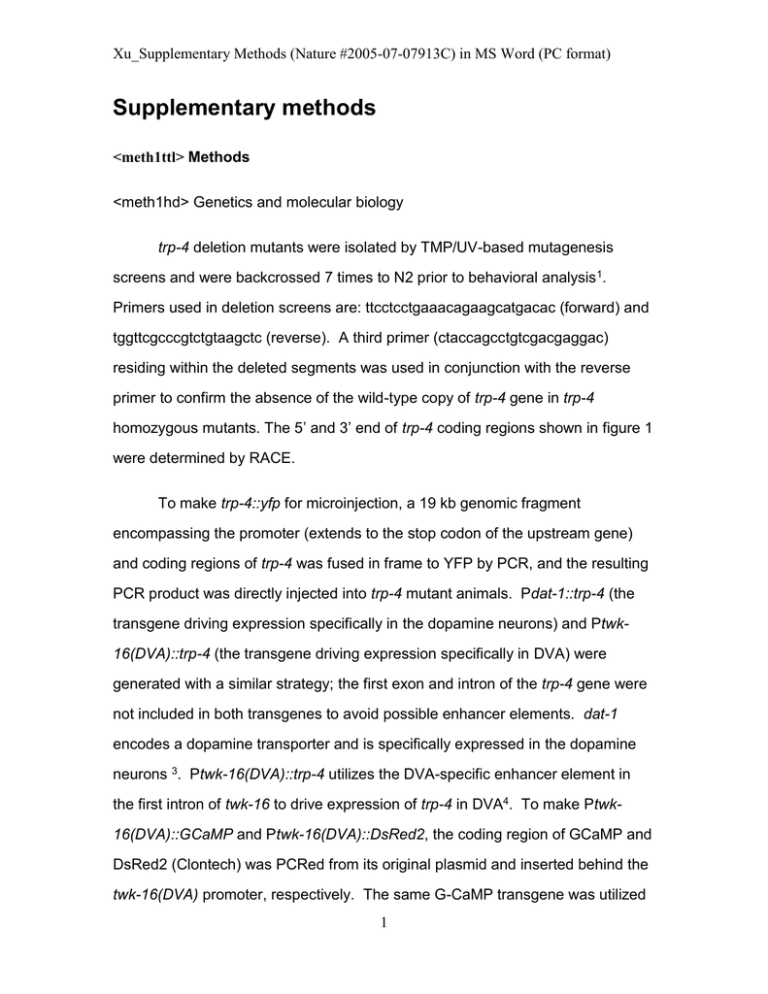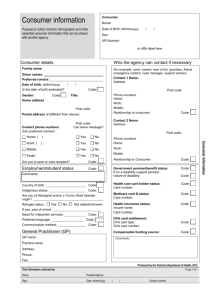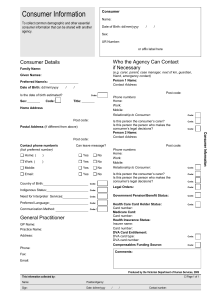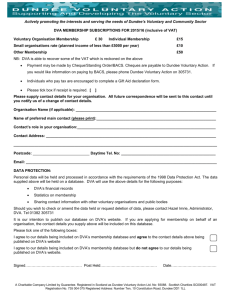Supplementary methods
advertisement

Xu_Supplementary Methods (Nature #2005-07-07913C) in MS Word (PC format) Supplementary methods <meth1ttl> Methods <meth1hd> Genetics and molecular biology trp-4 deletion mutants were isolated by TMP/UV-based mutagenesis screens and were backcrossed 7 times to N2 prior to behavioral analysis 1. Primers used in deletion screens are: ttcctcctgaaacagaagcatgacac (forward) and tggttcgcccgtctgtaagctc (reverse). A third primer (ctaccagcctgtcgacgaggac) residing within the deleted segments was used in conjunction with the reverse primer to confirm the absence of the wild-type copy of trp-4 gene in trp-4 homozygous mutants. The 5’ and 3’ end of trp-4 coding regions shown in figure 1 were determined by RACE. To make trp-4::yfp for microinjection, a 19 kb genomic fragment encompassing the promoter (extends to the stop codon of the upstream gene) and coding regions of trp-4 was fused in frame to YFP by PCR, and the resulting PCR product was directly injected into trp-4 mutant animals. Pdat-1::trp-4 (the transgene driving expression specifically in the dopamine neurons) and Ptwk16(DVA)::trp-4 (the transgene driving expression specifically in DVA) were generated with a similar strategy; the first exon and intron of the trp-4 gene were not included in both transgenes to avoid possible enhancer elements. dat-1 encodes a dopamine transporter and is specifically expressed in the dopamine neurons 3. Ptwk-16(DVA)::trp-4 utilizes the DVA-specific enhancer element in the first intron of twk-16 to drive expression of trp-4 in DVA4. To make Ptwk16(DVA)::GCaMP and Ptwk-16(DVA)::DsRed2, the coding region of GCaMP and DsRed2 (Clontech) was PCRed from its original plasmid and inserted behind the twk-16(DVA) promoter, respectively. The same G-CaMP transgene was utilized 1 Xu_Supplementary Methods (Nature #2005-07-07913C) in MS Word (PC format) for all calcium imaging studies by crossing it into different genetic backgrounds. Laser ablations were performed on L1 or L2 animals as previously described 2. The P values in figure 3 and figure 1 were determined by ANOVA with Dunnett test by comparing DVA and/or DVC ablated animals and mock ablated animals (for figure 3), and by comparing trp-4(sy695) or trp-4(sy696) and wildtype (for figure 1). The P values in figure 2 were determined with Student’s t-test by comparing animals moving on bacteria and those on agar. <meth1hd> Calcium imaging Calcium imaging was performed on a Zeiss Axiovert 200 microscope under a 40x objective. Images were acquired with a Roper CoolSnap CCD camera and processed by Ratiotool software (ISeeimaging). G-CaMP and DsRed2 (Clontech) fluorescence was excited at 484 nm and 535 nm, respectively. The fluorescence intensity of DsRed2 slowly decreases because of its relatively fast bleach compared to G-CaMP. The tail of individual animals was glued on an agarose pad with Nexaband cyanoacrylate glue (Fisher). Upon application of solution to the pad (14 mM Hepes [pH 7.4], 4 mM KCl, 145 mM NaCl, 1.2 mM MgCl2, 2.5 mM CaC12, and 10 mM glucose), animals then began to bend their body in the liquid, stimulating a robust increase in calcium level in DVA. To manually bend worm’s body, a glass pipette mounted on a micromanipulator was used to hold worm’s nose tip. To estimate bending angles, the experiment was then repeated under a 10x objective to allow for visualization of the entire animal, which is not possible under a 40x objective; thus, the estimation was indirect. Other protocols such as gentle touch of the body and nose did not elicit significant calcium response in DVA (n=5). To do so, 2 Xu_Supplementary Methods (Nature #2005-07-07913C) in MS Word (PC format) we glued the worm laterally on an agarose pad as previously described 5. A glass probe with a rounded tip was mounted on a micromanipulator, and the touch stimuli were delivered by moving the probe against the nose, the anterior or posterior part of the worm body to cause a deflection of <10 M. References 1. 2. 3. 4. 5. Jansen, G., Hazendonk, E., Thijssen, K. L. & Plasterk, R. H. Reverse genetics by chemical mutagenesis in Caenorhabditis elegans. Nat Genet 17, 119-21 (1997). Bargmann, C. I. & Avery, L. Laser killing of cells in Caenorhabditis elegans. Methods Cell Biol 48, 225-50 (1995). Nass, R., Hall, D. H., Miller, D. M., 3rd & Blakely, R. D. Neurotoxin-induced degeneration of dopamine neurons in Caenorhabditis elegans. Proc Natl Acad Sci U S A 99, 3264-9 (2002). Salkoff, L. et al. Evolution tunes the excitability of individual neurons. Neuroscience 103, 853-9 (2001). O'Hagan, R., Chalfie, M. & Goodman, M. B. The MEC-4 DEG/ENaC channel of Caenorhabditis elegans touch receptor neurons transduces mechanical signals. Nat Neurosci 8, 43-50 (2005). 3










